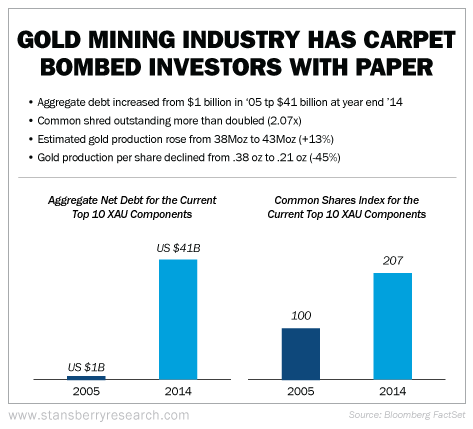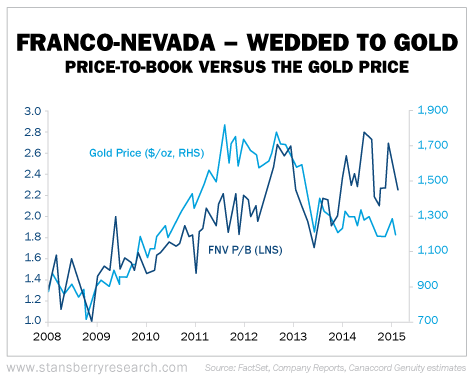| Home | About Us | Resources | Archive | Free Reports | Market Window |
This Gold-Royalty Play Is a BuyBy
Friday, December 11, 2015
Gold, an inert, unchanging metal, is immune to the foibles of human beings. Gold stocks are not.
I would like to share with you how big-brained and highly paid mammals drove gold stocks into the ground even though gold itself has not done badly. The yellow metal has doubled in the last 10 years. Meanwhile, gold stocks have been halved...
At Grant's Fall Investment Conference, I heard a thoughtful presentation by John Hathaway. He is the co-manager of the Tocqueville Gold Fund. Hathaway joined Tocqueville in 1997, though his investing career began in 1970.
Hathaway is a gold bull, but he lacks the fangs you'd normally associate with that crowd. Then again, running a gold fund for the last 10 years ought to be enough to humble any gold bug.
Hathaway's gold-fund track record is the kind of things that gives money managers nightmares. Down 23% year-to-date. Annualized returns of minus 30% for three years running and minus 20% for five years. Meanwhile, the S&P 500 zips along at 12%-13% annually. For a decade's worth of work, the Gold Fund has produced an annual return of negative 0.2%, versus 6.8% for the market overall.
As bad as that is, it's a lot better than gold stock indexes. So Hathaway showed, in a way I'm sure he'd rather not repeat, his stock-picking chops. A man with a lot of scar tissue, he took the podium and quietly shared what I thought was an astounding slide, pictured below.
 This chart really fascinates me. And I think part of it is the inescapable irony. Gold's great appeal is that it isn't paper and you can't dilute it. And here gold stocks have diluted their shareholders (doubling the shares outstanding!) and leveraged up more than fortyfold! If you want to know why gold stocks have done so badly, you can start with this chart.
What's also interesting is that all this capital thrown into mining hasn't done much to expand the supply of gold. "Mine life in the gold industry is currently 13 years," Hathaway said, "which is one of the lowest levels over the past 30 years." Discoveries have slowed to a trickle.
Now, for the first time in years, many gold stocks are cheaper than the cost to rebuild (or replace) assets. Replacement value is a good anchor to windward. If you consistently buy good assets below replacement cost, odds are good you won't lose money.
That's because markets respond to incentives. So, either of two things happens: 1) The stocks get bought out by bigger miners looking to add production, or 2) the gap narrows as the demand for new mines rises and the existing supply runs off. Replacement value isn't going down. And gold isn't going out of style.
Hathaway offered some speculations on the gold market itself and where the gold price might go. I'm far less interested in that question, because it is unknowable. I was more interested in his stock picks.
After listening to his recommendations, I was surprised he did not mention any gold royalty or streaming firms such as Royal Gold and Franco-Nevada.
Royalty and streaming companies don't do any mining themselves. They finance part of a mine's development in exchange for a percentage of what the mine produces over time. They are akin to financiers. As such, they escape a lot of the dirty work of mining. Their returns on their capital are better. Yet they still have upside to the metal itself.
In the gold stock universe, they've held up remarkably well. A 10-year look back at Franco-Nevada, the largest of the royalty/streamers, shows a price return of 325%, excluding dividends. This during a time when gold stocks, as measured by the GDX, were cut in half.
The question is always what to pay. As businesses, their return on invested capital (ROIC) is still low. ROICs for this group have been sub-5% for the last couple of years. And 2016 doesn't look to get better. See this table, which shows the estimated 2016 ROIC for each, from Canaccord Genuity:
Investing is not just about finding a neat business or betting on something that has worked in the past. You need to justify it based on the price you pay today. The basic way to price any business is to think about what it earns on the capital invested in it. So Franco-Nevada is a great company. But is a business that earns a sub-5% return on its invested capital worth two times book value?
The analysts at Canaccord Genuity asked the same question in a May report titled Royalty Returns. They compared the royalty companies with banks. It's not a bad comparison, considering that the royalty companies are, in essence, financiers:
The banking sector is generally valued on a price-to-book basis. Bank of America is at 0.72 times, while Goldman Sachs trades at 1.04 times. Bank of Montreal trades at 1.54 times, and Toronto-Dominion at 1.80 times. Scotia is at 1.68 times. Even assuming the average is 1.5 times, royalty/stream companies trade at a substantial premium to this metric.
These financials earn higher returns on their equity than the royalty stocks.
Yet the analysts come down on the side that the royalty companies deserve the premium because of the upside leverage to gold and silver, an upside absent from the banks. That makes sense as a hypothesis, but I'm not sure it should be that way.
In any event, I wouldn't buy the group. I'd buy the best-in-class player: Franco-Nevada. It is really without peers. Another interesting note from Canaccord:
Since 2008, FNV averaged an annualized ROE of 10.7% per quarter. The company's dividend policy has returned 18.4% to shareholders since inception, and in terms of yield (assuming a three-year trailing purchase), the company also stands alone. In its worst quarter, Franco generated breakeven ROE. In its weakest time, it recorded a $108 million write-down (or 3% of shareholders' equity at the time).
That is a heck of a record for a precious-metals stock.
And regardless of what I think the price-to-book ratio should be, the market has been consistent in rewarding FNV with a multiple that closely tracks the price of gold (which, in turn, influences FNV's return on equity).
 Arguably, there is a lot more opportunity for Franco-Nevada now. With gold miners struggling, capital is harder – and more expensive – to get. Franco-Nevada has plenty of dry powder for deals. It ought to face less competition. If you have a high conviction on the gold price, these royalty stocks belong in your portfolio. FNV, in particular.
Sincerely,
Further Reading:
Earlier this year, Steve showed readers that gold stocks are record cheap... "We can't know exactly when we've hit bottom," he says. "But this shows how much gold stocks can soar when they get going..." Learn more here: Gold Stocks Have NEVER Been This Cheap...
Before you invest one dime in natural resources like gold, this classic interview with master resource investor Rick Rule is a must-read. In it, he reveals everything you need to know to master the resource market's cyclicality. If you catch one of these big cycles at the wrong time, you can lose a fortune. But if you catch one early, you may never have to work again...
Market NotesMORE BAD NEWS FOR COAL Today, we check in on the state of the coal market... and as you'll see, it's not pretty...
We've written about the "dirty" commodity many times over the years. As regular readers are aware, the sector has been trending lower for a long time now. The popular coal fund KOL and the Dow Jones U.S. Coal Index are both down more than 50% this year. Natural gas is one of the main sources for electricity in the U.S. (generating more electricity than coal this past summer).
We can see this idea clearly by looking at the performance of Peabody Energy (BTU). Peabody is the largest coal company in the world. It's a good way to gauge what's going on in the industry. After jumping higher in late August, BTU shares have quickly gotten back on the losing track.
As you can see from the chart below, shares have plummeted more than 60% in the last two months alone and have just touched a new all-time low. Until this trend gets "less bad," it's wise to stay away from the sector...
 |
Recent Articles
|



